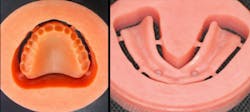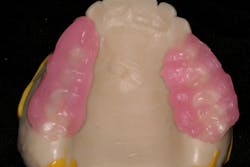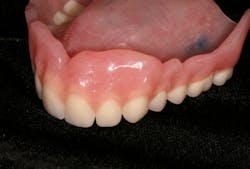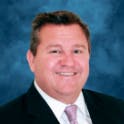Israel M. Finger, BDS, MS, MEd, and Gene Peterson, BS, CDT, discuss advantages of the AvaDent digital denture system and share a case study.
More than 35 million Americans do not have teeth, and many more in the United States are missing at least one tooth. (1) These numbers are expected to grow in the next two decades. (1) The consequences of tooth loss include poor nutrition, systemic disorders, reduced quality of life, and negative impacts on chewing and speaking. (2)
Denturescan mitigate these complications, but they require routine maintenance. If dentures are not properly maintained, bacteria can infiltrate the resin, which is inherently porous, and leave patients at risk for denture stomatitis, Candida albicans, and angular cheilitis. (3) Removable dentures are still a viable option for edentulous patients, and the AvaDent CAD/CAM digital denture system (Global Dental Science) is a product that allows dental professionals to create accurate dentures in fewer visits.
Advantages of the AvaDent digital denture system
Dentures can be fabricated in two appointments
All information is gathered during the first visit, and the dentures are inserted at the second visit. This allows the office to be more productive, and patients spend less time waiting for their new prostheses.
All workflow is digital
Tooth position and occlusal scheme are designed via the AvaDent design software. All tooth movements are coordinated and calculated in relation to one another to ensure clinically correct results. A variety of tooth forms and occlusal schemes are available.
The denture is set up virtually
The dentist can view the tooth setup and make all necessary changes without additional dental visits (figure 1). The 3-D viewer allows the dentist to collaborate with the dental laboratory without having to send the case back and forth. Once the setup is accepted, the denture will be manufactured. If you prefer a try-in visit, this is possible too; the denture will be completed in three visits instead of two.
Figure 1: Digital preview (click to enlarge)
The denture is milled
The AvaDent denture is produced by machining a prepared cylinder of acrylic resin, or polymethyl methacrylate (PMMA) (figure 2). (4) This is advantageous because this block of resin has significantly fewer free monomers and porosities. This results in less bacterial adhesion and fewer instances of complications associated with free monomers. The block—which looks like a hockey puck—is available in various shades. It is a very strong material, so milling a prosthesis results in less distortion or shrinkage than dentures fabricated using conventional methods. (5)
Figure 2: A PMMA puck with milled sockets, from the occlusal and intaglio perspectives
The denture teeth are milled
The teeth are milled to full contour from a patented, preshrunk, bacteria-resistant, polychromatic PMMA that is extreme cross-linked. The AvaDent Signature Teeth can be individually modified in size and form to accommodate variations in occlusion, eliminate spaces, or idealize esthetics.
Treatment planning is flexible
AvaDent offers complete dentures, immediate dentures, and implant prostheses.
All information is stored digitally
Digital records offer convenience and protection for every patient. Should a patient ever lose or damage a denture, a new AvaDent denture can be recreated quickly. The digital record allows AvaDent to reproduce the esthetics and occlusion previously achieved for each patient.
Case presentation
A patient presented with an old maxillary denture and mandibular partial denture. The patient's chief complaint was about the esthetics of the maxillary denture, specifically the reverse smile line (figure 3).
Figure 3: The patient's initial presentation. Note the reverse smile line from the original maxillary denture.
Upon examination, it was concluded that the reference denture record procedure technique could be used to construct the new denture and complete the process in two visits. A reference denture is a duplicate of a patient's existing prosthesis. The patient’s existing denture was examined, and the esthetics and occlusal relationship were evaluated. This technique requires a thorough evaluation of any wear on the occlusal surfaces and of the vertical dimension of occlusion (VDO). The reference denture was used as a custom impression tray to record the intaglio surface, make a bite registration, and identify the midline and anterior tooth positions. The reference denture can also be used as an occlusal rim.
A final impression was made with a light-bodied polyvinylsiloxane (PVS) impression material (figure 4). The VDO was examined, and wax was added to the occlusal surface of the posterior teeth to increase VDO (figure 5). The anterior teeth and the contours of the posterior teeth were changed with flowable composite resin (figure 6). Jaw relations were made. The reference denture and centric relation record were sent to the laboratory for scanning.
Figure 4: The final impression with the reference denture used as a custom impression tray. This final impression was made with a light-bodied PVS impression material.
Figure 5: Wax was added to occlusal surfaces to raise and record the proper VDO.
Figure 6: Esthetic modifications with flowable composite resin. Note the addition to the incisal edge length and the contours of the posterior teeth to create a more pleasing appearance.
Authors' note: To see the laboratory fabrication procedures, watch this video.
The denture was delivered using a conventional technique: denture border length, fit, retention, support, stability, VDO, occlusion, and function were all evaluated. When the denture was delivered, disclosing paste was used to check for any pressure points on the intaglio surface (figure 7). Esthetics were verified (figure 8), and the patient was given hygiene instructions.
Figure 7: Final denture with indelible ink to mark pressure spots
Figure 8: A happy patient at denture delivery
Summary
The AvaDent digital denture system offers a practical approach to fabricating dentures without numerous, unnecessary appointments. This system offers many advantages, and the technique is user-friendly.
Editor's note: This article first appeared in Pearls for Your Practice: The Product Navigator. Click here to subscribe. Click here to submit a products article for consideration.
References
1.Facts & Figures. American College of Prosthodontics website. www.gotoapro.org/facts-figures.
2. Jones JA, Orner MB, Spiro A 3rd, Kressin NR. Tooth loss and dentures: Patients' perspectives. Int Dent J. 2003;53(Suppl 5):327-334.
3. Felton D, Cooper L, Duqum I, et al. Evidence-based guidelines for the care and maintenance of complete dentures: A publication of the American College of Prosthodontists. J Am Dent Assoc. 2011;142(Suppl 1):1S-20S.
4. Carlos A. Munoz, DDS, MSD, professor of restorative dentistry, School of Dental Medicine, SUNY Buffalo.
5.Goodacre BJ, Goodacre CJ, Baba NZ, Kattadiyil MT. Comparison of denture base adaptation between CAD-CAM and conventional fabrication techniques. J Prosthet Dent. 2016;116(2):249-256.
















